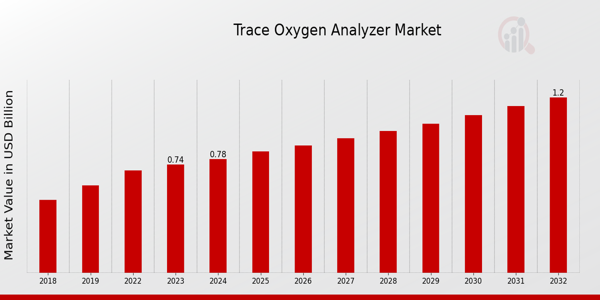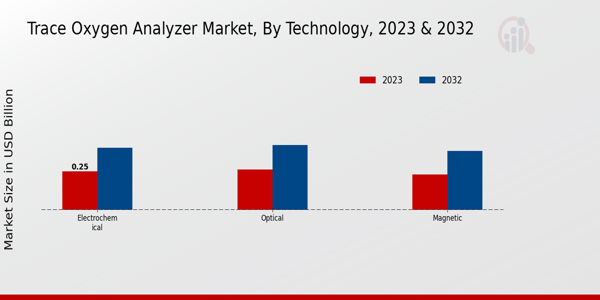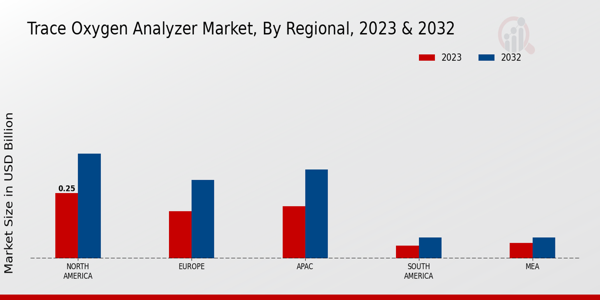Trace Oxygen Analyzer Market Overview:
As per MRFR analysis, the Trace Oxygen Analyzer Market Size was estimated at 0.82 (USD Billion) in 2024. The Trace Oxygen Analyzer Market Industry is expected to grow from 0.87 (USD Billion) in 2025 to 1.40 (USD Billion) till 2034, at a CAGR (growth rate) is expected to be around 5.48% during the forecast period (2025 - 2034).
Key Trace Oxygen Analyzer Market Trends Highlighted
The Global Trace Oxygen Analyzer Market is experiencing significant growth driven by increasing safety regulations across various industries. Industries such as healthcare, food and beverage, and oil and gas are prioritizing oxygen monitoring to ensure product quality and worker safety. This focus on compliance is a key market driver as companies seek reliable solutions to monitor oxygen levels and prevent contamination. In addition, advancements in technology are facilitating the development of more sensitive and accurate analyzers. This is leading to a rise in demand for real-time monitoring systems, further propelling market expansion. Currently, there are numerous opportunities to be explored in this market.The growing adoption of trace oxygen analyzers in emerging economies presents a vast potential for companies to expand their presence. As industries continue to evolve and modernize, there is a rising need for improved monitoring solutions that can cater to specific requirements. Furthermore, the integration of these analyzers with IoT technology can enhance data collection and analysis, opening new avenues for innovation and growth. Recent trends indicate a shift towards portable and user-friendly analyzers that are easy to operate and maintain. The emphasis on digital solutions is reshaping the market landscape, as end-users are now more inclined to invest in devices that offer connectivity and remote monitoring capabilities.Additionally, sustainability is becoming a priority, prompting a demand for analyzers that can support eco-friendly practices in various sectors. Overall, the Global Trace Oxygen Analyzer Market is positioned for steady growth, driven by technological advancements, regulatory demands, and a growing awareness of the importance of oxygen monitoring across diverse applications.

Source: Primary Research, Secondary Research, MRFR Database and Analyst Review
Trace Oxygen Analyzer Market Drivers
Increasing Demand for Quality Control in Manufacturing Processes
The Global Trace Oxygen Analyzer Market Industry is experiencing a significant boost in demand driven by the increasing emphasis on quality control across various manufacturing processes. Industries such as pharmaceuticals, food and beverage, aerospace, and electronics are particularly reliant on maintaining specific oxygen levels to ensure product integrity and safety. These sectors require precise monitoring of oxygen levels to prevent oxidation, which can lead to spoilage or degradation of products.The rising awareness concerning the critical role of trace oxygen levels in preserving the quality and extending the shelf life of products is a substantial factor driving market growth. Additionally, the regulatory frameworks in many countries mandate stringent quality control measures, further propelling the need for effective trace oxygen analyzers. The trend towards automation and the implementation of advanced monitoring systems also contribute to the increasing integration of trace oxygen analyzers into production lines, providing real-time data that helps manufacturers maintain optimal conditions.This growing adoption within diverse industries signifies a substantial opportunity for the Global Trace Oxygen Analyzer Market Industry.
Technological Advancements and Innovations
Technological advancements have profoundly influenced the Global Trace Oxygen Analyzer Market Industry by enhancing measurement accuracy and ease of use. Innovations in sensor technology, data analytics, and IoT integration allow for more efficient monitoring of trace oxygen levels in real-time. The shift towards more sophisticated and user-friendly analyzers enables industries to adopt these devices without extensive training, broadening their application range.
There will be an increase in the demand for more sophisticated trace oxygen analyzers as industries ever look for ways to enhance the processes and reduce errors stimulating the growth in the market.
Growth of the Pharmaceutical and Biotechnology Sectors
The growth in the pharmaceutical and biotechnology sectors is driving demand for trace oxygen analyzers, as these industries require stringent quality control measures during production. The necessity for maintaining the integrity of products due to stringent regulations and quality standards increases the reliance on precise oxygen monitoring solutions. This trend is critical for the Global Trace Oxygen Analyzer Market Industry as it encounters growing demand in these sectors, ensuring consistent market growth.
Trace Oxygen Analyzer Market Segment Insights:
Trace Oxygen Analyzer Market Technology Insights
The Technology segment of the Global Trace Oxygen Analyzer Market is witnessing a steady growth trajectory, expected to achieve a valuation of 0.74 USD Billion in 2023 and projected to reach 1.2 USD Billion by 2032, demonstrating the market's potential as it matures. The landscape is primarily composed of three key technologies: Electrochemical, Optical and Magnetic. The Electrochemical technology holds a significant position in this market, with a valuation of 0.25 USD Billion in 2023, forecasted to grow to 0.4 USD Billion by 2032, underlining its importance in applications requiring precise oxygen measurement. This sub-segment is characterized by its ability to provide accurate data in various industries, including environmental monitoring and medical applications, which contributes to its dominant market share. Optical technology also plays a crucial role, accounting for a market value of 0.26 USD Billion in 2023, with expectations to rise to 0.42 USD Billion by 2032. The advantages of Optical technology, such as non-destructive testing and high sensitivity, make it a preferred choice in high-tech applications like aerospace and advanced manufacturing. As industries seek improved monitoring capabilities, the significance of this technology continues to grow, reflecting a notable upward trend in the market.Meanwhile, the Magnetic technology represents a smaller slice of the market, valued at 0.23 USD Billion in 2023 and likely to increase to 0.38 USD Billion by 2032. While this segment is less dominant compared to its counterparts, it addresses niche applications, particularly in research environments where unique measurement capabilities are necessary. Despite its lesser market share, it holds value in specialized fields such as scientific research and technical developments.
Overall, the segmentation within the Global Trace Oxygen Analyzer Market highlights significant growth potential across the Technology domain, driven by the increasing demand for accurate and reliable oxygen measurement solutions. With advancements in technology and a broader focus on safety and quality assurance across industries, the market is expected to experience a positive outlook as each technology, while unique, contributes to the overall efficiency and innovation within the sector. The ongoing trend of industries investing in monitoring equipment bolsters the Global Trace Oxygen Analyzer Market revenue and opens avenues for future developments across various technologies. Despite facing challenges such as competition from alternative technologies, the opportunities in the market are substantial, especially as the demand for environmental consciousness and safety regulations rises across the globe.

Source: Primary Research, Secondary Research, MRFR Database and Analyst Review
Trace Oxygen Analyzer Market Application Insights
This evolution has been particularly pronounced in sectors such as Pharmaceuticals, where precise oxygen detection is crucial for ensuring drug stability and efficacy, thereby driving demand. The Food and Beverage industry also exhibits significant growth potential, as oxygen levels can directly impact product quality and shelf life, making trace oxygen analyzers essential for compliance and quality assurance.
Environmental Monitoring represents another major area, increasing in importance as industries aim to adhere to stringent regulations regarding pollutant levels and ecological preservation. Lastly, the Industrial Gas segment plays a vital role, as accurate oxygen measurement is necessary for optimizing processes and enhancing safety in gas storage and distribution. With the diverse applications across these verticals, the Global Trace Oxygen Analyzer Market segmentation reveals a landscape characterized by robust growth opportunities driven by technological advancements and regulatory compliance demands. Collectively, these insights highlight the dynamic nature of the market, supported by emerging trends and the critical need for regulatory adherence across multiple industries.
Trace Oxygen Analyzer Market End Use Insights
This growth can be largely attributed to the increasing demand across different end-use categories such as Laboratory, Manufacturing and Research. Laboratories are essential for ensuring the accuracy of oxygen measurements in various analytical processes, making them a significant driver in this market. The manufacturing sector represents a crucial area as well, where trace oxygen levels can critically affect product quality and operational efficiency.Research applications demand precise measurements to advance scientific studies and innovations, contributing to the market's expansion. As the Global Trace Oxygen Analyzer Market segmentation highlights, these end-use applications not only dominate the market but also create substantial opportunities for technological advances and improved instrumentations, which are vital for businesses looking to maintain competitive advantages. Overall, the Global Trace Oxygen Analyzer Market statistics reflect a robust trend driven by increasing awareness regarding quality control in numerous industries, ultimately reflecting positive market growth dynamics
Trace Oxygen Analyzer Market Sales Channel Insights
In the realm of sales channels, the market showcases a diverse framework, primarily categorized into Direct Sales, Distributors and Online Sales. Each channel plays a crucial role in the overall dynamics of the market. Direct Sales facilitate immediate customer engagement, often leading to strong relationships and tailored solutions, while Distributors help broaden the reach of products, ensuring accessibility across various regions.Online Sales have gained prominence due to the increasing digitalization and demand for convenient purchasing options, thereby enhancing market penetration. As companies in the Global Trace Oxygen Analyzer Market industry adapt to evolving market trends, they harness the strengths of each sales channel to meet the diverse needs of their clientele, driving robust sales growth. Moreover, the insights derived from Global Trace Oxygen Analyzer Market data reveal that the online segment is surging ahead, reflecting the growing preference for e-commerce solutions in a technologically-driven environment, thereby becoming a significant contributor to overall market statistics.
Trace Oxygen Analyzer Market Regional Insights
The Regional segment of the Global Trace Oxygen Analyzer Market showcases significant diversity, with North America holding a major share valued at 0.25 USD Billion in 2023, projected to grow to 0.4 USD Billion by 2032, driven by advancements in industrial applications and stringent regulatory requirements. Europe follows closely with a valuation of 0.18 USD Billion in 2023, expected to reach 0.3 USD Billion in 2032, reflecting the region's commitment to technological integration in healthcare and manufacturing sectors. Asia-Pacific (APAC) is also becoming increasingly prominent, starting at 0.2 USD Billion in 2023 and growing to 0.34 USD Billion by 2032, owing to the rise in demand for analytical instruments in emerging economies.South America and the Middle East and Africa (MEA) represent smaller yet notable opportunities, valued at 0.05 USD Billion and 0.06 USD Billion, respectively in 2023, both anticipated to increase modestly by 2032. The variance in market valuation across these regions is indicative of varying levels of industrialization, technological adoption, and a focus on maintaining quality standards, thus highlighting the importance of regional insights in understanding the overall Global Trace Oxygen Analyzer Market data and statistics.

Source: Primary Research, Secondary Research, MRFR Database and Analyst Review
Trace Oxygen Analyzer Market Key Players and Competitive Insights:
The Global Trace Oxygen Analyzer Market is characterized by a competitive landscape shaped by technological advancements and increasing demand for precision in various applications such as environmental monitoring, industrial processes, and research laboratories. As industries seek to ensure quality control and compliance with regulatory standards, trace oxygen analyzers have gained prominence for their ability to measure oxygen levels with high sensitivity and accuracy. Companies operating in this sector are focused on innovation, aiming to enhance product performance and expand their market reach through strategic partnerships, mergers, acquisitions, and the development of new technologies.
The competitive dynamics highlight the importance of research and development initiatives, as well as customer-centric approaches that address specific industry needs.Thermo Fisher Scientific stands out in the Global Trace Oxygen Analyzer Market due to its comprehensive portfolio and reputation for delivering high-quality scientific instruments. The company's commitment to innovation is evident in its advanced trace oxygen analyzers, which leverage state-of-the-art technology to achieve exceptional measurement sensitivity and reliability. Thermo Fisher Scientific leverages its extensive distribution network and strong brand presence to capitalize on demand across various sectors, including pharmaceuticals, food and beverage, and environmental monitoring. The company excels in providing tailored solutions, empowering clients with the ability to optimize processes while maintaining stringent safety and quality standards. Its emphasis on customer support and service further solidifies its position as a leader in the market, allowing for enduring relationships with its diverse clientele.Setra Systems has established itself as a noteworthy player in the Global Trace Oxygen Analyzer Market by focusing on high-performance measurement solutions tailored for critical applications. The company emphasizes innovation and precision engineering in its product offerings, catering to niche markets where accuracy is paramount. Setra Systems is recognized for its ability to deliver reliable and accurate measurements, making its trace oxygen analyzers ideal for industries that require stringent monitoring, such as semiconductor manufacturing and aerospace. With a commitment to customer satisfaction, Setra Systems maintains a strong presence by providing exceptional technical support and product training, ensuring that end-users can fully leverage the capabilities of their analyzers. The company’s focus on quality, combined with its responsive approach to market demands, positions it favorably against its competitors in the trace oxygen analyzer landscape.
Key Companies in the Trace Oxygen Analyzer Market Include:
-
Thermo Fisher Scientific
-
Setra Systems
-
Parker Hannifin
-
Yokogawa Electric
-
Vaisala
-
Teledyne Technologies
-
Analytical Technology
-
Siemens
-
ABB
-
Ametek
-
Honeywell
-
Horiba
-
Endress+Hauser
-
Emerson Electric
-
Metrohm
Trace Oxygen Analyzer Market Industry Developments
Recent developments in the Global Trace Oxygen Analyzer Market have highlighted significant advancements and growing competitiveness among key players such as Thermo Fisher Scientific, Setra Systems, Parker Hannifin, and Yokogawa Electric. The demand for trace oxygen analyzers in industries like pharmaceuticals, food and beverage, and aerospace continues to surge, driven by stringent quality control measures and regulatory compliance. Companies like Vaisala and Teledyne Technologies have enhanced their product lines by integrating advanced technologies that improve accuracy and reliability. In terms of mergers and acquisitions, there have been notable movements as companies pursue strategic collaborations to expand market reach and capabilities.
For instance, Ametek has shown interest in acquiring complementary technologies to strengthen its position in the market. Additionally, Honeywell and Siemens are actively innovating to improve their solutions, recognizing the growing importance of trace oxygen detection in various applications. The market valuation for these companies is experiencing robust growth, reflecting an increased investment in R&D, bolstering their competitive edge in the Global Trace Oxygen Analyzer landscape. The collective advancements and corporate strategies are reshaping the market dynamics, indicating a promising future for the sector.
Trace Oxygen Analyzer Market Segmentation Insights
Trace Oxygen Analyzer Market Technology Outlook
- Electrochemical
- Optical
- Magnetic
Trace Oxygen Analyzer Market Application Outlook
- Pharmaceutical
- Food and Beverage
- Environmental Monitoring
- Industrial Gas
Trace Oxygen Analyzer Market End Use Outlook
- Laboratory
- Manufacturing
- Research
Trace Oxygen Analyzer Market Sales Channel Outlook
- Direct Sales
- Distributors
- Online Sales
Trace Oxygen Analyzer Market Regional Outlook
- North America
- Europe
- South America
- Asia Pacific
- Middle East and Africa
| Report Attribute/Metric |
Details |
|
Market Size 2024
|
0.82 (USD Billion)
|
|
Market Size 2025
|
0.87 (USD Billion)
|
|
Market Size 2034
|
1.40 (USD Billion)
|
|
Compound Annual Growth Rate (CAGR)
|
5.48 % (2025 - 2034)
|
|
Report Coverage
|
Revenue Forecast, Competitive Landscape, Growth Factors, and Trends
|
|
Base Year
|
2024
|
|
Market Forecast Period
|
2025 - 2034
|
|
Historical Data
|
2020 - 2024
|
| Market Forecast Units |
USD Billion |
| Key Companies Profiled |
Thermo Fisher Scientific, Setra Systems, Parker Hannifin, Yokogawa Electric, Vaisala, Teledyne Technologies, Analytical Technology, Siemens, ABB, Ametek, Honeywell, Horiba, Endress+Hauser, Emerson Electric, Metrohm |
| Segments Covered |
Technology, Application, End Use, Sales Channel, Regional |
| Key Market Opportunities |
Growing industrial automation needs, Increasing demand for pharmaceuticals, Enhanced focus on environmental monitoring, Rising applications in food packaging, Technological advancements in sensor technology |
| Key Market Dynamics |
Increasing industrial applications, Stringent regulatory standards, Technological advancements in analyzers, Growing demand for quality control, Rising awareness of product safety |
| Countries Covered |
North America, Europe, APAC, South America, MEA |
Frequently Asked Questions (FAQ) :
The Global Trace Oxygen Analyzer Market is expected to reach a value of 1.2 billion USD by 2034.
The market is expected to grow at a CAGR of 5.48% from 2025 to 2034.
North America is projected to hold the largest market share, valued at 0.4 billion USD by 2034.
In 2023, the Electrochemical technology was valued at 0.25 billion USD, Optical at 0.26 billion USD, and Magnetic at 0.23 billion USD.
The Global Trace Oxygen Analyzer Market was valued at 0.74 billion USD in 2023.
Major players in the market include Thermo Fisher Scientific, Setra Systems, Parker Hannifin, and Yokogawa Electric.
The Asia-Pacific region is anticipated to grow to 0.34 billion USD by 2034.
The European sector was valued at 0.18 billion USD in 2023.
Key challenges may include technological advancements and regulatory compliance affecting product adoption.
Growing industrial applications and increasing demand for process automation present significant opportunities for market growth.

















